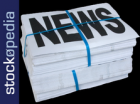Partly nationalised banking group, Royal Bank Of Scotland (LON:RBS) was the darling of the UK banking sector this week on speculation that it may be looking to buy its way out early from the Government's Asset Protection scheme that insures the bank's most toxic assets. The RBS share price was up 5.2% to 44.9p following indications in the Financial Times that it was working on plans to pull out at the end of this year. RBS is 83% owned by the taxpayer following a bailout in the wake of the credit crunch. It recently paid £700 million of APS fees as its second installment through to the end of 2011. The APS was introduced in 2009 to insure a pool of £282bn of toxic assets in order to restore confidence after the financial crisis.
It is thought that the APS protection has become increasingly unnecessary for the bank. RBS must shoulder the first £60 billion of losses (after that HM Treasury would cover 90 per cent of losses) and its total net loss is now thought to be below this as bad debts reduce. If it decided to leave the scheme at the end of the year, it could avoid the £500m payment due for 2012, although it would still need to pay a £400m topup to meet its minimum commitment. Analysts at JP Morgan Cazenove (NYSE:JPM) said that:
“We would see this as a positive for sentiment, as it would make RBS cleaner for the ultimate sale of the Government's stake. ‘
The outperformance by RBS this week was in contrast to the rest of the banking sector peers. However, to a large extent, this reflects the degree to which the RBS valuation has been hit by its difficulties in recent years. While Barclays (LON:BARC) was down almost 4% this week, at 301p, the Barclays share price is trading close to 40% of its all-time high (790p in February 2007). This reflects the way Barclays adroitly escaped much of the reputational damage from a government bailout through seeking out external investors. In contrast, even at 45p, the Royal Bank of Scotland share price is still less than 10% of its peak (687p in the same month of 2007). Although it is 41% taxpayer owned, its other peer




